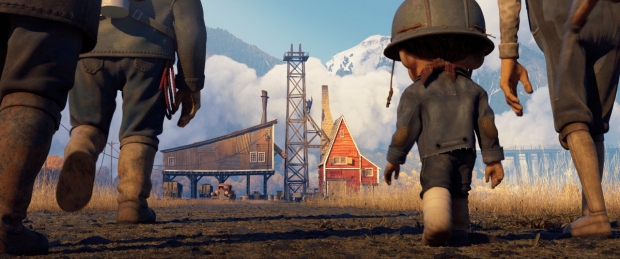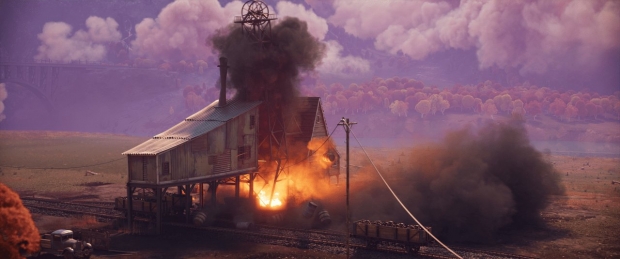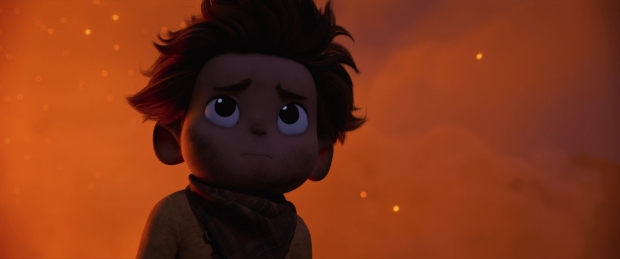It took P-H Dallaire and Benoit Therriault a decade to find the right partner – Rodeo FX – to produce their 3DCG animated short about a young boy and a chipper little bird who work in a dank, dark coal mine.
Plenty of filmmakers have created animations centered around a child and their furry friend. But very few contain the emotional depth and complexity that accompanies the dark and dangerous setting of a 1920s coal mine.
Long hours of constant hard labor where the sun doesn’t shine, minimal light, low ceilings and frequent accidents from cave-ins or toxic fumes, not to mention deadly black lung caused by breathing in excessive amounts of coal dust. It seems hardly the place to tell the story of a young boy and his chipper bird friend. But that’s exactly what we get with directors P-H Dallaire and Benoit Therriault’s short film, CANARY.
It’s 1922 and a young boy named Sonny works in an underground coal mine with a group of adult miners; his primary responsibility is taking care of the caged canary which the men use to detect deadly methane gas. Hoping to escape the dank and gloomy underground, the boy teaches his bird to play dead. The clever prank sends the panicked miners to the surface, where Sonny and the canary enjoy playing in the sunlight. At least, for a short while.
The prank is discovered by an adult minor, the boy and his bird are dragged back into the shadows of the mine. But when an annoyed Sonny naively ignores the dangers of the game he is playing, it leads to a tragedy he may never recover from.
The project - with animation and effects from Dumbo’s and Mowgli’s Rodeo FX - has been a long time coming for Dallaire and Therriault (known as PH & Ben), who are also known by their more comedic shorts Itchy the Camel: Rakes and Outside? But CANARY isn’t about hilarity and problem-solving, it’s about childhood, it’s about growing up, and it’s about grief. But the directors also hope that their film, while somber, also gives others hope.
The film is currently on this year’s festival circuit and has already been an Audience Award winner at Warsaw Film Festival, an EBS Prize Short Film winner at Bucheon International Animation Festival (BIAF), a winner of The Mohaq Best Short Film for Ajyal Film Festival, and more.
We got to talk with Dallaire and Therriault about the many years spent on this story, why it took so long to tell and what they hope audiences take away from Sonny and his canary now that the story is, at last, complete and in line for Oscar voting for Best Animated Short. Voting begins Monday, December 12.
But first, check out a sneak peek at the film:
Victoria Davis: Not many people are aware of the role canaries played in mining back in the 20s, let alone that they were still used up through much of the 80s. How did your team come across this info?
Benoit Therriault: It’s something that was sort of always present in the culture growing up in the 80s, but still pretty metaphorical.
P-H Dallaire: As a kid, I played a video game which referenced an actual canary in a coal mine. So, it was still kind of imbued in culture and hadn’t yet faded to the point that only the popular metaphor remained. It’s interesting to think that so few of us realized it referred to something that actually happened in very recent history.
VD: You’ve said in other interviews that, “CANARY’s simple message and creative soul was the perfect story for Rodeo FX to bring to life.” Can you explain that further? What drew the team to this story and what made it a good fit for the studio?
PH & Ben: This is an idea we had more than 10 years ago, on the 12th of August 2012 to be exact. We really believed in the idea and discovered, as we pitched it to our friends and animation colleagues, that there was a universal response to a story about a little boy and his little bird in an underground coal mine.
When we were looking for a home for the film, Rodeo FX made a lot of sense. They specialize in the type of detailed environments and realistic effects (smoke, fire, explosions, etc.) that we envisioned for the film as well as the types of stylized animated characters that we love to create.
Thankfully, the pitch was well received by Sébastien Moreau, the CEO at Rodeo FX, and the rest is history.
VD: Since this is 3D, many of the characters have their own level of intricate detailing, but the canary character is definitely on a whole other level. The little yellow bird was absolutely stunning for a creature with such simple features. Can you talk about what it took to bring this bird to life? What were your goals with the design?
PH & Ben: Because it’s a short film, the story requires the viewer to root for the characters immediately, so universal appeal was absolutely necessary for our two main characters. Our goal on this film was to have very simple shapes for the characters so we could then layer on the more complex details. For Sonny, the boy miner, he has this beautiful head of hair hiding just under his helmet.
For the canary, the details were all in the feathers and down coat. The shapes of the primary wing feathers were designed and then detailed down to individual fiber strands forming each feather. The down coat on his body combines multiple feather types, beautifully groomed into place. But the keywords and driving principles were fairly simple: fluffy and appealing.
VD: I also really enjoyed the detailed walls of the cave. How much research was done on coal mines for this project?
PH & Ben: We did a ton of research. Our biggest disappointment was we didn’t get a chance to go down into an underground coal mine before production as it was the beginning of winter, and all the old coal mines are closed to tourists for the season. We were thrilled when actual miners saw the film at FCIAT, a renowned international festival in northern Canada, and they told us they were convinced of the film’s authenticity. That’s when it felt like we had done things right!
To get the look, we went through tons of archival footage and historical photos and watched underground mine footage shot by some modern - day explorers - all very claustrophobic stuff. This research was instrumental in capturing the essence of the underground which we stylized to fit the look and feel we wanted for the film.
VD: In a short, every scene counts, and you try to make the most of every moment both visually and narratively. Do you have any favorite scenes when it came to the animation?
PH & Ben: The first sequence we completed was the one where the young miner, Sonny, offers the canary a sunflower seed. This was special because seeing the characters and their relationship finally come alive on screen gave us the confidence that the film would work.
VD: Were any new tech or tools (such as rigging tools) developed for the production?
PH & Ben: The majority of the film was created with Houdini software using Solaris, which allowed us to create a new USD pipeline. Scene assembly, shading, groom and feathers, lighting, and renders were done in Houdini, while character rigging and animation were done in Maya. But our Houdini-centric approach included prototyping some character rigs in Houdini, since this was faster than Maya to test and identify desirable rig behaviors. AnimBot was also a popular tool for the animators on the film.
VD: One feature of this film - that might not seem like a big deal to viewers but is definitely a big deal to those who understand the production side - is the constant dust and smog in the mines. How do you keep the character details looking so good within such a realistic-looking dank and dark environment?
PH & Ben: This really was one of the big challenges for lighting and visual effects on this production. There was a lot of testing of the volumetric smoke and light effects, at different distances, early on in production to get a good sense of what works and what doesn’t; communicating a sense of darkness, but not losing the details, balancing the values of the light to maintain a sense of depth, and not allowing the smoke and dust to absorb too much light, which would flatten the image.
We had a great combination of artistry and technical wizardry in our lighting director of photography, and he managed to strike the right balance where the cheats are not apparent, and the characters stand out for their performances.
VD: This was a story your studio has wanted to tell for 10 years. Why did it take so long to come to fruition? Were there big challenges along the way?
PH & Ben: The biggest challenge was finding a way to make CANARY. That was what the 10-year journey was really about, not losing faith in the idea, being willing to take risks, and finally leaving our previous jobs when it became clear it would be impossible to make the film with that company. And, thankfully, finding Sébastien Moreau and Rodeo FX, where the film found a home.
It’s worth mentioning that the nature of this relationship with the studio has been so important because part of filmmaking inevitably involves trial and error and, at Rodeo, we found partners who demonstrated they had trust in us and allowed us to explore the story and find the best way to tell it.
Building the pipeline while making the film was also quite challenging. Luckily, the talented artists we hired, many of them long-time collaborators, were up to the task.
VD: Looking back on all the years working to make this happen, now that it’s complete, what was the most enjoyable part about making this film?
PH & Ben: The most enjoyable part for us is always working with the team. Films are entertainment, but they also represent an immense team effort. We were surrounded by the right people, and they believed in the idea. Some even left their jobs to join us on this adventure and that was such an amazing level of commitment. We wanted to honor that commitment by helping everyone create a film they would be proud of in the end. We put that pressure on ourselves so we wouldn’t let anyone down. The fact that our team is proud of it means everything to us.
VD: The end of this story is… complicated and there are a few ways it can be interpreted. What do you personally hope audiences take away from the film?
PH & Ben: We believe that anyone’s interpretation of the film is as valid as ours at this point as it’s out there and belongs to audiences now. But ultimately, we want the film to be a celebration of life and leave audiences feeling hopeful.












